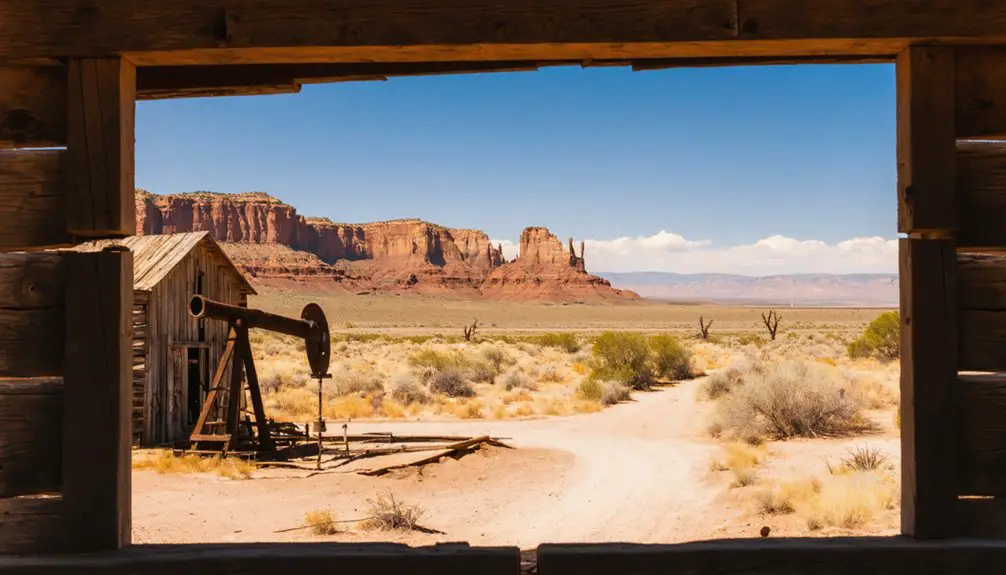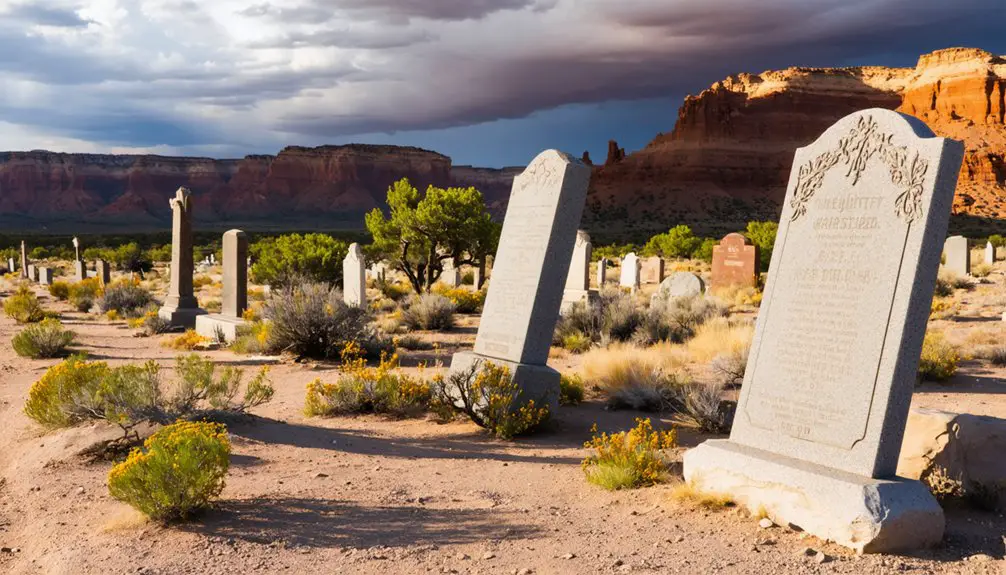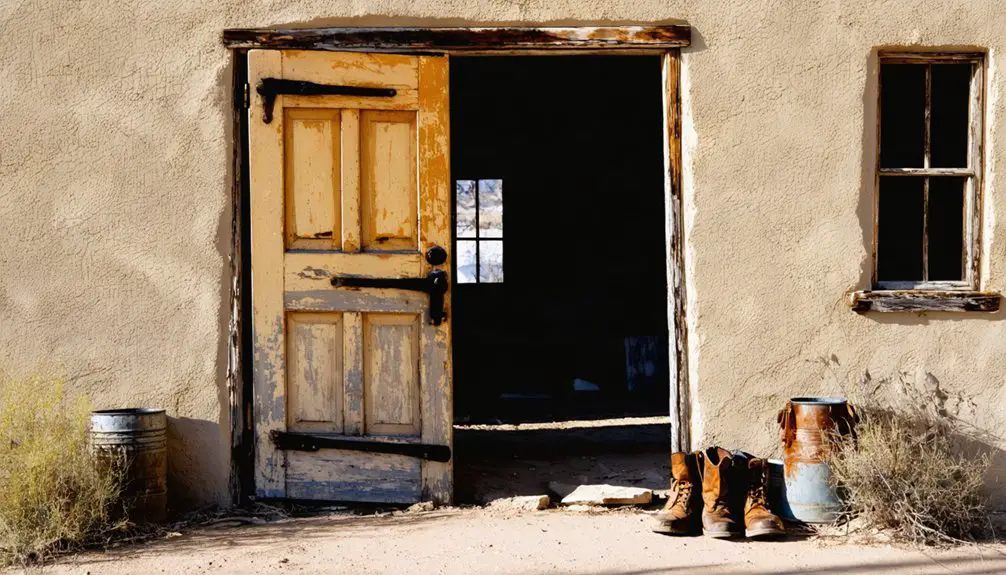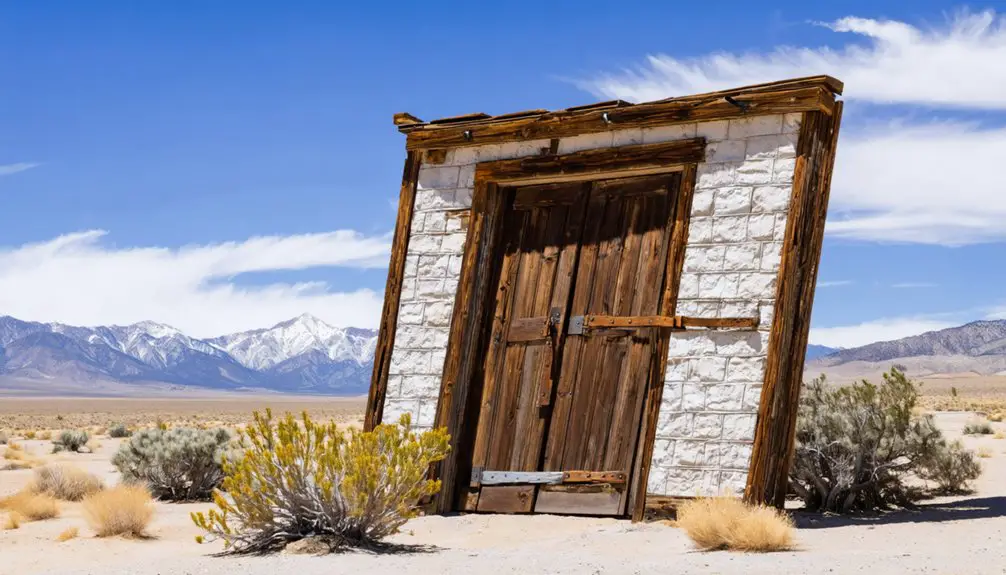You’ll find Georgetown, Utah nestled beneath Rockport Reservoir’s waters, where it once thrived as a Mormon pioneer settlement established in the 1860s. The community sustained itself through cotton farming and fruit cultivation until the Bureau of Reclamation’s Wanship Dam project submerged it in 1957. While most structures are gone, an abandoned cabin and the historic cemetery with 80 graves dating from 1860-1910 hold fascinating tales of pioneer life and Southern Paiute connections.
Key Takeaways
- Georgetown was established in the 1860s as part of Mormon colonization efforts in southern Utah’s Dixie region for cotton and fruit cultivation.
- The town faced persistent water management challenges and poor soil conditions, making sustainable agriculture nearly impossible to maintain.
- The Wanship Dam project by the Bureau of Reclamation (1954-1957) submerged the original townsite, forcing residents to abandon Georgetown.
- A historic cemetery with approximately 80 graves from 1860-1910 remains as one of the few tangible remnants of Georgetown’s existence.
- Only one abandoned cabin near the original townsite survives today, with no restored buildings or modern tourism facilities.
The Pioneer Settlement of Georgetown
Georgetown emerged as one of several key settlements established during the Mormon Church‘s southern Utah colonization initiative of the 1850s and 1860s. The pioneer motivations centered on creating a self-sustaining community that wouldn’t need to rely on non-Mormon outsiders.
You’ll find this settlement was strategically positioned in Utah’s warmer Dixie region, where longer growing seasons supported cotton, fruit, and tobacco cultivation. Like the town of St. George, which was named for George A. Smith, Georgetown was part of the broader colonization effort. The settlement joined nearly eight hundred families who were called to colonize the Dixie region in the early 1860s.
The settlement strategies focused on cooperative labor and family-based colonization. Under leaders like Nathan Tenney, settlers worked together to build irrigation systems and forge alliances with local Paiute tribes, who helped identify prime agricultural land.
The community’s location complemented other Mormon outposts like St. George and Parowan, forming a network of settlements that strengthened the church’s presence in southern Utah.
Life in Early Georgetown
If you’d visited Georgetown in its early days, you’d have witnessed pioneers rising before dawn to tend crops and livestock while carefully managing their precious water allotments through communal irrigation ditches.
Water resource management dominated daily life, with families coordinating schedules to guarantee fair distribution through a network of channels that sustained their arid farming ventures. Similar to Grafton’s early settlers, they faced persistent challenges from Virgin River flooding.
The tight-knit community gathered regularly for barn raisings, harvest celebrations, and religious services, where they’d share news, resources, and support each other through the challenges of frontier life. Like miners in Silver Reef Ghost Town, they relied heavily on the geological resources of the region.
Daily Pioneer Routines
The daily rhythms of pioneer life in Georgetown revolved around sunup-to-sundown labor, where survival depended on careful time management and hard work.
You’d start your pioneer chores before dawn, tending to livestock care – feeding cattle, sheep, and horses while checking fences and structures for overnight damage.
Throughout the day, you’d balance intensive agricultural tasks with domestic duties. While men worked the fields with basic tools, women managed the household, carrying water from wells and cooking on wood stoves. Much like the hardworking settlers of Grafton in 1859, the community worked together to establish farms and build homes.
Children helped with lighter tasks, from gathering eggs to mending clothes. In the evenings, you’d join neighbors for communal activities like quilting bees or storytelling. Disease and natural disasters were constant threats, as evidenced by the devastating impact of flooding and illness that forced Grafton’s early settlers to abandon their homes.
Despite the harsh conditions and constant threat of disease or injury, religious gatherings and community support helped sustain your determination to build a life in this challenging frontier.
Water Resource Management
Living in early Georgetown meant securing reliable water access was your paramount concern, as the semi-arid Utah climate posed constant challenges for both survival and agriculture.
You’d rely heavily on local streams and springs, developing essential water conservation practices through manually dug wells and cisterns. Your irrigation techniques focused on small-scale systems to sustain crops and livestock, with the community’s roughly 27 families sharing limited resources by the 1950s. The Bureau of Reclamation took charge of transforming the landscape between 1954-1957. The severe drought conditions today have exposed the town’s original foundations for the first time since its flooding.
This way of life changed dramatically when the federal government initiated the Wanship Dam project.
The resulting Rockport Reservoir submerged Georgetown under 62,100 acre-feet of water by 1957, forcing you to abandon traditional water management methods. Control shifted from local hands to centralized federal and state oversight, forever altering the region’s relationship with its water resources.
Community Social Activities
Despite geographic isolation, social life in Georgetown revolved around a vibrant community spirit centered at the local church until its branch closure in 1921. You’d find community gatherings focused on shared meals, storytelling, and music, with the church serving as both a spiritual hub and news center.
The restored old church building hosted celebrations marking agricultural milestones and religious events, fostering social cohesion among settlers. Similar to the cotton-growing pioneers of nearby communities, residents worked together to build a sustainable farming lifestyle. Weekly dances became a cherished tradition that brought the community together for entertainment and socializing.
Local entertainment was homegrown, featuring dances and outdoor games on wooden sidewalks. Children played outdoors while contributing to daily chores, and families relied on mutual aid for survival.
When Harry Sherman brought movie filming to the area, it provided rare external cultural exposure. Through floods, disease outbreaks, and conflicts with Native tribes, these social bonds helped preserve the community’s resilience.
Notable Residents and Families
Several Mormon pioneer families established Georgetown in 1859 under Brigham Young’s “Cotton Mission” directive, forming the backbone of this early settlement.
You’ll find the Poinkum Legacy woven into the area’s history through the presence of this respected Native American figure and his family, who lived from 1847 to 1905. His sons, Puss and Wiley, became well-known local figures alongside their father.
The tragic Berry Incident marked a dark chapter when the Berry family fell victim to Native American retaliation, highlighting the region’s complex pioneer-indigenous relations.
Notable community members included medical practitioners and mine foremen like Michael Carbus from nearby Silver Reef.
While the town’s population peaked at just 28 residents in 1869, these families’ influence shaped the area’s development until its eventual abandonment in 1945.
Water Challenges and Environmental Impact

Georgetown’s early settlers faced significant water challenges as they tried to develop agriculture in the arid region, with their 1890-1891 attempt to divert Cottonwood Spring’s water failing due to gypsum soil absorption.
You’ll find that without reliable water infrastructure, the town’s agricultural potential remained severely limited throughout its early history, as residents relied primarily on springs and small-scale wood-pipe systems.
The persistent water scarcity issues you see in Georgetown’s history mirror broader regional challenges that continue today, as drought conditions and climate variability increasingly threaten water resources across northern Utah.
Drought and Water Scarcity
While Utah has historically faced water challenges, the extreme drought conditions affecting over 88% of the state have reached unprecedented levels, particularly evident in the dramatic decline of Rockport Reservoir.
You’ll find the reservoir’s capacity has plummeted from 82% to a mere 29%, marking its lowest level since its creation 64 years ago.
These drought patterns have exposed long-submerged ghost towns and historical artifacts, including Georgetown near Yellow Creek, where water sustainability issues led to its abandonment by the late 1940s.
The severity of current conditions is highlighted by summer water levels dropping to depths typically seen only in autumn.
You’re witnessing a critical moment as this drought threatens water storage capacity, affecting agricultural, household, and industrial needs statewide.
Agriculture’s Limited Potential
Despite initial hopes for agricultural prosperity, Georgetown’s farming potential faced severe limitations from both environmental and infrastructural challenges. You’d find crop diversity severely constrained by poor soil conditions, while farming techniques like dry farming couldn’t overcome the area’s natural limitations.
The rudimentary irrigation systems constantly clogged with silt, making reliable water delivery nearly impossible despite nearby water sources.
When you look at the environmental impact, you’ll see how agricultural settlement transformed the landscape. Native vegetation gave way to crop monocultures, while grazing cattle compacted the soil.
The challenges proved insurmountable – small-scale farming couldn’t achieve economies of scale, and competition for limited resources with neighboring towns forced many farmers to relocate.
What remained were degraded lands and abandoned farms, evidence of Georgetown’s unsuccessful agricultural ambitions.
Buildings and Infrastructure
Located in Utah’s arid desert climate, the buildings and infrastructure of Georgetown once supported a modest community of approximately 100 residents.
Despite its remote desert setting, Georgetown’s modest buildings and infrastructure once provided a home for a hundred resilient Utah settlers.
The town featured basic building materials suited to desert conditions, including wood construction with possible stone foundations. Key structures included a store, school, and post office that served as central gathering points for the community.
Today, you’ll find just one visible remnant of Georgetown’s past – a small abandoned cabin near the original townsite.
Unlike other Utah ghost towns such as Grafton or Silver Reef that maintain multiple preserved structures, Georgetown’s infrastructure design has largely vanished.
The town’s 2WD-accessible roads still connect to nearby Cannonville, but you won’t find any modern tourism amenities or restored buildings at this remote desert location.
The Cemetery: Stories Set in Stone

A somber tribute to frontier life lies in Georgetown’s historic cemetery, where approximately 80 graves dating from 1860 to 1910 tell stories of both settlers and Southern Paiute people.
Many grave markers have vanished over time, though the Berry family plot remains prominent, enclosed by a wooden fence near the cemetery’s center.
The cemetery’s tragic tales reflect the harsh realities of frontier life:
- 1866’s “Hard Year” claimed 13 lives through epidemics, accidents, and conflicts.
- Berry family members fell victim to Navajo raids during settlement struggles.
- Young lives were particularly vulnerable, with numerous child burials.
Ghost tales persist, including the famous 1927 sighting of two accident victims from 1866, adding to the cemetery’s mystique as a monument to Georgetown’s complex pioneer history.
Daily Life and Community Activities
Life beyond Georgetown’s cemetery walls revealed a vibrant community where daily routines centered on farming, mining, and commerce.
You’d find settlers tending their fields daily, while others ventured into nearby mines extracting precious ore. Local saloons and general stores served as bustling hubs where you could purchase essential supplies or share stories over drinks.
Miners and farmers toiled daily while saloons buzzed with activity, offering both supplies and social connection in Georgetown.
Community bonding flourished through social gatherings like the 1903 Thanksgiving masquerade ball, where isolation didn’t dampen spirits.
You’d witness children playing near graveyards and on swings, while adults gathered for storytelling sessions sharing local legends.
Despite challenges from floods, diseases, and conflicts with Indigenous peoples, residents maintained their sense of unity through these daily interactions.
Without formal churches, they created their own traditions, adapting to life in this rugged frontier town.
The Path to Abandonment

Despite Georgetown’s resilient community spirit, the town’s path toward abandonment began with its unreliable water supply along Yellow Creek. The harsh realities of Southern Utah’s arid climate made agriculture and daily living increasingly difficult, setting the stage for the town’s eventual decline.
The primary abandonment reasons that sealed Georgetown’s fate were:
- Chronic water shortages that made sustainable farming impossible
- Limited economic factors, with only basic services like a store and post office
- Regional pressures, including conflicts and the development of better-situated towns
Exploring Georgetown Today
Situated in Utah’s rugged landscape, Georgetown stands today as a symbol of pioneer perseverance, though its remaining structures tell a quieter story than many of the state’s better-known ghost towns.
Time has softened Georgetown’s pioneer spirit, leaving behind weathered ruins that whisper tales of Utah’s resilient past.
When planning your Georgetown exploration, you’ll need to prepare for a self-guided experience with minimal amenities or signage. The site’s original schoolhouse, store, and post office likely remain in various states of preservation, offering you glimpses into early pioneer life.
Unlike its more famous neighbor Grafton, ghost town tourism at Georgetown remains relatively undeveloped. You won’t find guided tours or interpretive displays here.
While the town shares historical connections with nearby Cannonville through its namesake George Q. Cannon, you’ll discover a raw, unpolished piece of Utah’s past that rewards independent adventurers.
Frequently Asked Questions
Are There Any Reported Ghost Sightings or Paranormal Activity in Georgetown?
You won’t find documented ghost encounters specific to Georgetown, though you’ll discover similar paranormal investigations in nearby ghost towns like Grafton, where reports include mining spirits and white apparitions.
What Indigenous Peoples Lived in the Georgetown Area Before Mormon Settlement?
Like ancient guardians of the land, you’d find the Ute Tribe dominated Georgetown’s territory, with some Shoshone influence from the north. They thrived there for centuries before Mormon settlers arrived in 1847.
How Far Is Georgetown From Bryce Canyon National Park?
From Georgetown’s historic location in southern Utah’s rugged geography, you’ll need to drive about 130-135 miles to reach Bryce Canyon National Park, typically taking around 2.5 hours by car.
Did Any Movies or Television Shows Ever Film in Georgetown?
You won’t find documented film productions or television series shot in Georgetown. While Utah’s ghost towns have attracted filmmakers, there’s no evidence of any shows using Georgetown as a filming location.
Can Visitors Legally Collect Artifacts or Souvenirs From Georgetown’s Ruins?
No, you can’t legally collect any artifacts from the ruins. Federal legal restrictions strictly protect the site, and artifact preservation laws make removing items from this BLM-managed land a punishable offense.
References
- https://onlineutah.us/georgetownhistory.shtml
- https://lifeinutopia.com/utah-ghost-towns
- https://www.youtube.com/watch?v=AoiIha-3iNo
- https://www.ksl.com/article/51362209/how-the-past-lingers-in-these-utah-ghost-towns
- https://www.ghosttowns.com/states/ut/georgetown.html
- https://www.uen.org/utah_history_encyclopedia/c/COLONIZATION_OF_UTAH.shtml
- https://www.sunriver.com/bucketlist-living/golf-tips-thumb-thing-interesting-s5z8k
- https://archives.utah.gov/2021/04/01/utahs-road-to-statehood-latter-day-saint-pioneers/
- https://en.wikipedia.org/wiki/Mormon_pioneers
- https://graftonheritage.org/history-settlement/



